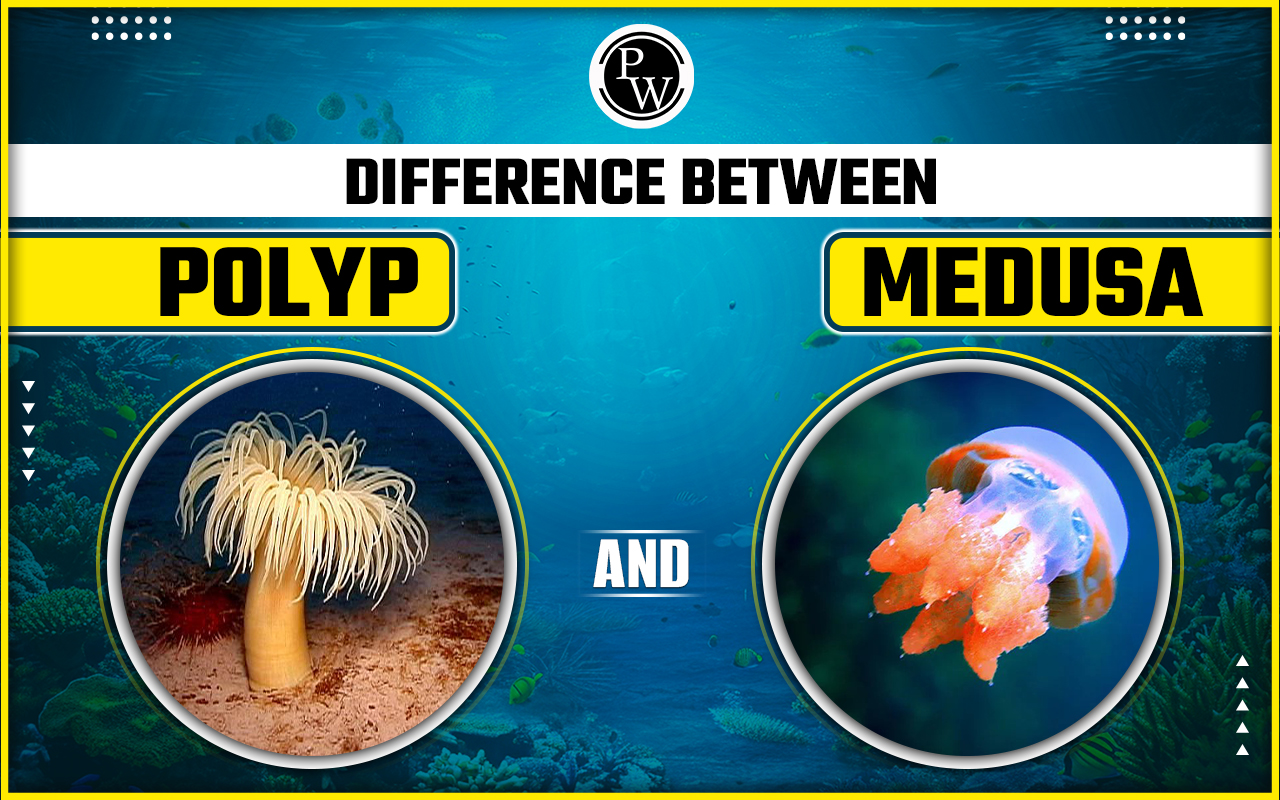

Difference Between Polyp and Medusa: Polyps and medusae are two distinct stages in the life cycle of organisms in the phylum Cnidaria, which includes jellyfish and sea anemones. Aquatic invertebrates have two body forms: polyps, which are nonmotile, and medusae, which often swim freely. While some species exist only as polyps or medusae, others go through both life cycle stages. Polyps, which are stationary and sessile organisms, include solitary examples like sea anemones and freshwater hydra. The medusa, or free-swimming stage, is commonly called a jellyfish. The following article discusses the difference between polyp and medusa.
| NEET Biology Syllabus | NEET Biology Diagrams |
| NEET Biology MCQ | NEET Biology Chapter wise Weightage |
| NEET Biology Notes | NEET Previous Year Question papers |
Difference Between Polyp and Medusa Overview
Polyp and Medusa are two distinct body forms within the phylum Cnidaria, which includes jellyfish, corals, and sea anemones. These forms represent various developmental stages in the creatures' life cycles. Polyps have cylindrical or vase-shaped bodies and are sessile, attaching themselves to substrates like rocks or shells. They have a mouth surrounded by tentacles that serve as both feeding and defense mechanisms. Medusae, on the other hand, are free-swimming organisms that resemble jellyfish. They have bell-shaped bodies and trailing tentacles. Polyps, with cylindrical or vase-shaped bodies, are stationary and adhere to substrates. They have tentacles around their mouth for feeding and defense, reproduce asexually through budding, and have specialized sensory structures known as statocysts. Furthermore, they tend to live longer than Medusae. Medusae, with their bell-shaped bodies, can move freely through the water and capture prey with trailing tentacles. They reproduce sexually and have rhopalia, which are specialized sensory structures that help them perceive their surroundings. They have shorter lifespans than polyps due to their larger size. Read the article below for more information on the difference between polyp and medusaDifference Between Polyp and Medusa
Polyps typically reproduce asexually and are suited to sedentary living, whereas medusae reproduce sexually and are capable of free-swimming. The transition between these two forms is known as metagenesis or generation alternation, a key feature of the cnidarian life cycle. The primary difference between polyps and medusae is in their body structures and functions. The following table provides the difference between polyps and medusae.| Difference Between Polyp and Medusa | ||
|---|---|---|
| Characteristic | Polyp | Medusa |
| Definition | A polyp represents one of the forms found in Cnidarians, featuring a tubular body and a stationary lifestyle. | A medusa is one of the forms found in Cnidarians, characterized by a saucer-shaped body and a free-floating lifestyle. |
| Mobility | Polyps are immobile, fixed to a surface or substrate. | Medusae are mobile organisms capable of free-swimming. |
| Shape | They typically exhibit a more or less cylindrical shape with a long stalk. | They display an umbrella-like shape with a reduced stalk. |
| Habitat | Polyps are typically attached to underwater rocks or other surfaces. | Medusae are commonly found in open water. |
| Adaptation | They are adapted for a sessile or sedentary existence. | They are adapted for a floating lifestyle. |
| Body Structure | Polyps have a simple body structure consisting of a cylindrical trunk and a flattened oral disc. | Medusae possess a more complex body structure, including a central bell and numerous marginal tentacles. |
| Mesoglea | Polyps have a poorly developed mesoglea. | Medusae have a highly developed mesoglea. |
| Manubrium | Absent in polyps. | Medusae of the class Hydrozoa feature a tube-like manubrium that hangs down from the bell. |
| Mouth | Polyps have a single circular and terminal mouth. | Medusae have a four-sided mouth located downwards or at the lower end of the hanging manubrium. |
| Tentacles | Tentacles surround the mouth in the form of a ring. | Tentacles surround a central bell and hang downwards at the margin. |
| Gastrovascular Cavity | The gastrovascular cavity in polyps is simple, lacking radial and circular canals. | Medusae possess four radial canals and one circular canal. |
| Nerve Cord | Polyps lack a nerve cord, hence are unable to move independently. | Medusae have a nerve cord, enabling them to move autonomously. |
| Sense Organs | Absent in polyps. | Medusae possess eight sense organs known as statocysts and photoreceptors. |
| Velum | Absent in polyps. | Present in medusae. |
| Gonads | The majority of polyps lack gonads, although some may produce them. | Medusae typically have four gonads located on radial canals. |
| Evolution | Polyps are considered primitive forms. | Medusae are evolved from polyps. |
| Function | Polyps primarily feed and protect the colony. | Medusae participate in sexual reproduction and species distribution. |
| Reproductive Mode | Polyps mainly reproduce asexually by budding or sexually by spawning following pheromone release. | Medusae exclusively reproduce sexually by releasing gametes underwater. |
| Examples | Examples of polyps include Hydra, Corals, and Sea anemones. | Medusae examples include Jellyfish. |
About Polyp
The polyp is a stationary stage in the life cycle of animals from the group called Cnidarians. Some well-known examples of polyps include sea anemones and mature corals. A polyp has a mouth surrounded by tentacles, kind of like a head, and it's attached to the ground by a foot-like disk. It usually faces its mouth and tentacles toward the water. Polyps can reproduce in two ways: they can make new polyps by budding, where little buds grow into new individuals, or they can reproduce sexually by releasing special cells into the water during spawning. Polyps have two main functions:- Reproduction: Polyps are responsible for making new polyps. They can do this by budding, where little buds grow into new polyps, or by releasing special cells into the water during spawning.
- Feeding and attachment: Polyps attach themselves to surfaces like rocks or coral reefs and use their tentacles to catch food. They spend a lot of time feeding and growing.
About Medusa
The medusa is a life stage in the Cnidaria phylum of animals. Hydrozoa, which include jellyfish, are one of the most common animals with a medusa stage. The medusa has a bell-shaped appearance and can swim due to muscular contractions. Surrounding the bell are various tentacles, including photoreceptors and gravity-sensing cells. In the Hydrozoa class, the medusa typically features a manubrium structure, like a tube hanging down from the bell with the mouth at its end. Reproduction in the medusa stage is primarily sexual, although the method of development varies within the Cnidaria phylum. For example, in the Hydrozoa class, new individuals are formed by budding, while in other classes such as Cubozoa or Rhizostomeae, medusae are produced through the metamorphosis of the polyp. The functions of the medusa stage are as follows:- Reproductive Role: Medusae serve as the sexual, free-swimming stage in the life cycle. They produce eggs and sperm for sexual reproduction, and fertilized eggs develop into larvae, which then transform into polyps.
- Mobility: Medusae are mobile and capable of swimming, allowing them to move around and explore new areas. This mobility is essential for finding mates and engaging in sexual reproduction.
Difference Between Polyp and Medusa FAQs
What are the polyp and medusa stages of Obelia?
In certain species of Obelia, ingestion of tintinnids and microplanktonic organisms occurs through grazers. During the polyp stage, the mouth is positioned at the top of the body, surrounded by tentacles, while in the medusa stage, the mouth is situated at the distal end of the main body structure.
What distinguishes a polyp from a medusa, and what type of symmetry do they exhibit?
Both stages display radial symmetry. The polyp stage tends to be sessile, while the medusa stage is mobile. Some species of Cnidarians exhibit bioluminescence.
What are the differences between polyps and medusae?
Medusae have bell-shaped bodies with hanging tentacles, whereas polyps lack a manubrium. In the Hydrozoa class, the medusa stage possesses a manubrium, which is a tube hanging from the bell. Polyps lack sensory organs.
Is Hydra a polyp or medusa?
Hydra, perhaps the most well-known hydrozoan, remains in the polyp stage throughout its life cycle and never undergoes a medusoid stage.
What are the similarities between polyps and medusae?
Both polyps and medusae have tentacles armed with stinging cells called cnidocytes, which they use for defense, feeding, and capturing prey. Additionally, they both originate from a single ancestral form and represent different stages in the cnidarian life cycle.
🔥 Trending Blogs
Talk to a counsellorHave doubts? Our support team will be happy to assist you!

Free Learning Resources
PW Books
Notes (Class 10-12)
PW Study Materials
Notes (Class 6-9)
Ncert Solutions
Govt Exams
Class 6th to 12th Online Courses
Govt Job Exams Courses
UPSC Coaching
Defence Exam Coaching
Gate Exam Coaching
Other Exams
Know about Physics Wallah
Physics Wallah is an Indian edtech platform that provides accessible & comprehensive learning experiences to students from Class 6th to postgraduate level. We also provide extensive NCERT solutions, sample paper, NEET, JEE Mains, BITSAT previous year papers & more such resources to students. Physics Wallah also caters to over 3.5 million registered students and over 78 lakh+ Youtube subscribers with 4.8 rating on its app.
We Stand Out because
We provide students with intensive courses with India’s qualified & experienced faculties & mentors. PW strives to make the learning experience comprehensive and accessible for students of all sections of society. We believe in empowering every single student who couldn't dream of a good career in engineering and medical field earlier.
Our Key Focus Areas
Physics Wallah's main focus is to make the learning experience as economical as possible for all students. With our affordable courses like Lakshya, Udaan and Arjuna and many others, we have been able to provide a platform for lakhs of aspirants. From providing Chemistry, Maths, Physics formula to giving e-books of eminent authors like RD Sharma, RS Aggarwal and Lakhmir Singh, PW focuses on every single student's need for preparation.
What Makes Us Different
Physics Wallah strives to develop a comprehensive pedagogical structure for students, where they get a state-of-the-art learning experience with study material and resources. Apart from catering students preparing for JEE Mains and NEET, PW also provides study material for each state board like Uttar Pradesh, Bihar, and others
Copyright © 2025 Physicswallah Limited All rights reserved.
Get App










